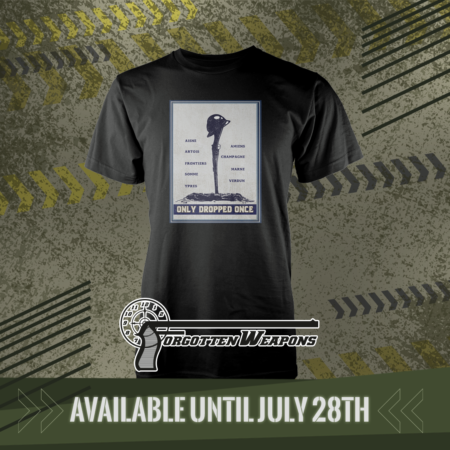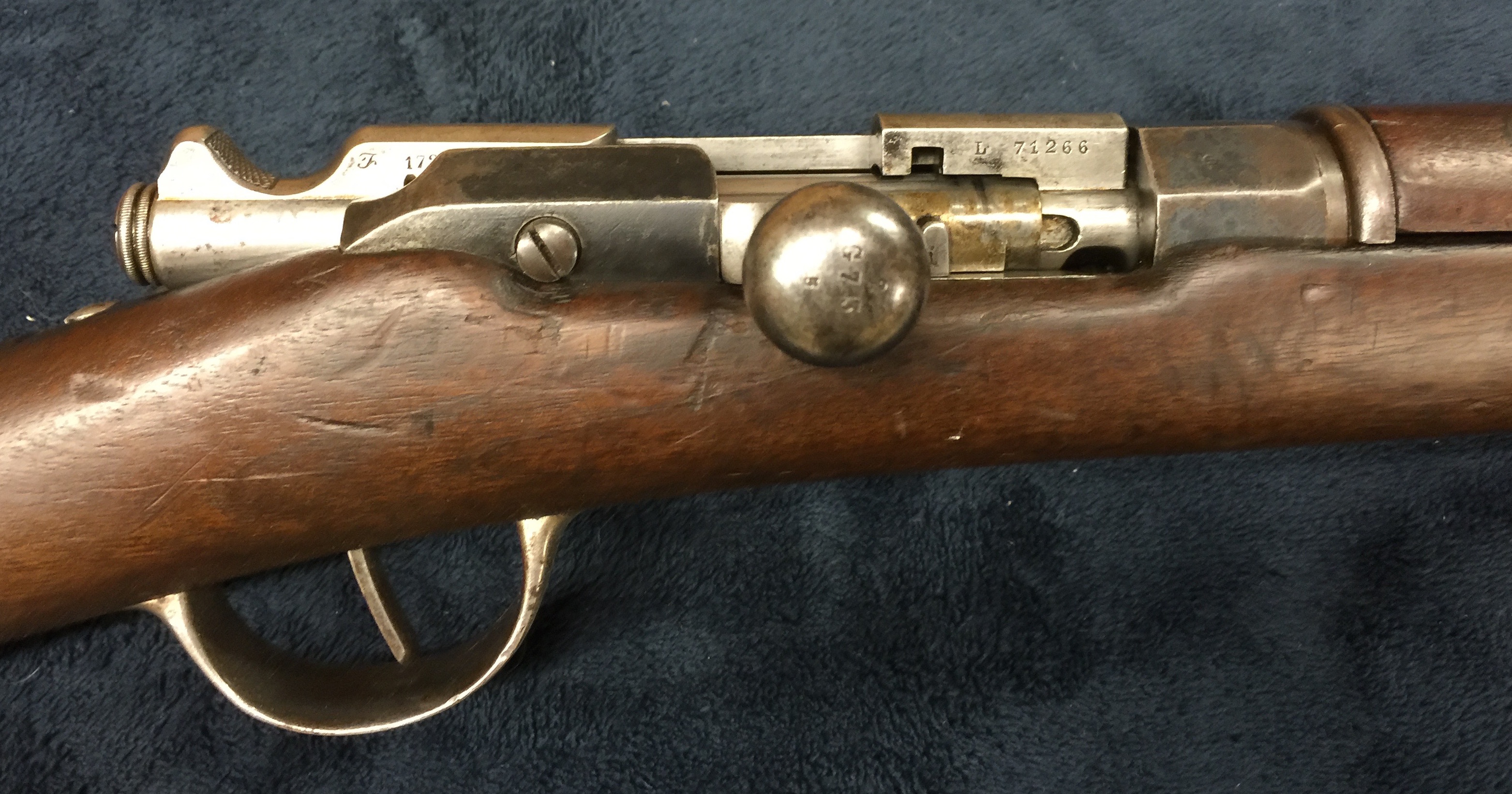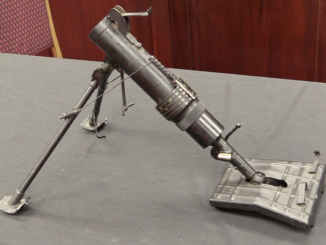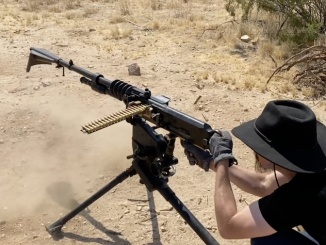When the Modele 1890 Berthier carbine was adopted for the French cavalry, the decision was made to produce a special version for the Cuirassier troops. These were the elite heavy cavalry, equipped with steel breastplates and elaborate plumed helmets. They existed in that very brief window where the worlds of Napoleon and the smokeless-powder rifle coexisted.
The armor worn by the Cuirassier required some special adaptations to their firearms, specifically to the stocks. The scaled chinstrap of the helmet interfered with a normal cheek weld to the carbine, so the comb was removed from the stock. The metal buttplate also was a poor match for the metal cuirass, as it was difficult to hold the gun in position to aim. To account for this, a leather buttplate was used on these carbine, which would be much less slippery on armor.
Aside from these changes to the stock, the carbine was identical to the standard 1890 cavalry carbine. A total of 20,000 Cuirassier carbines were made in 1891 at the Chatellerault arsenal, and few survived World War One. By fairly early in 1915 the cavalry units had been repurposed as infantry, and the Cuirassier went into the trenches with the armor and carbines – perhaps better equipped, ironically, than the infantry in the greatcoats, kepis, and with Lebel rifles.
Thanks to Justin for finding this rifle for me!





Always surprising how long some armies held on to the Cuirassier. The French Cuirassiers were slaughtered at both Woerth and Sedan when they rode against needle guns; keeping them around against smokeless powder repeating rifles was just folly.
There were still two beliefs in play;
1. The cuirass could stop a bullet.
Answer; Slightly true. The plate cuirass could generally stop a musket ball or a pistol ball, providing both were over .60 caliber and traveling at under 500 feet-per-second at impact. Instead of penetrating, they would leave a deep dent and a nasty bruise under it, even through an arming doublet, a quilted, wool-padded armless vest generally worn under he uniform jacket. (The quilted vest worn
by epee’ fencers even today is basically the same thing.)
Such an arrangement would not, however, stop a bullet from a rifle-musket, or any of the newer breechloaders. It particularly would not stop the 8mm Lebel bullet, in either round-nosed or spire-pointed persuasion, as those were generally monolithic bullets cast and then machined from solid brass or bronze rather than being made up like “regular” jacketed bullets.
2. The gorget was necessary to protect the cuirassier from being thrust in the throat by an opposing cavalryman’s saber.
Answer; entirely correct. That maneuver was still a standard one with cavalry right up to World War One. Cavalry on horseback generally fought each other with pistol and saber; the carbine was mainly for use when on foot, while skirmishing. The drill was the same as dragoons; eight men from each squadron of ten dismounted and formed the skirmish line while the nos. 5 and 10 took the horses to the rear.
The cuirassier was rapidly out-evolved by the weapons technology of the day, but as long as some of the older methods were still in use, he had a reasonably good argument for sticking to his own SOP.
cheers
eon
“There were still two beliefs in play(…)”
Note also that 1914 French doctrine called to attaque à outrance, which is why French army still used red color in field uniforms, from
http://www.151ril.com/content/gear/1914
(…)Bold and brilliant in color, it is another relic suited more for the battlefields of the 19th century and the age before smokeless powder.(…)striking red that was intended to instill a sense of boldness in the soldier(…)
Similar thinking might be behind this armor (to boost esprit de corps).
As side note, Phillppe Pétain, advance slowly through French army ranks, as he abandoned this doctrine in favor of firepower. First World War give evidence that he was right.
As example see this drawing from 1910:
https://commons.wikimedia.org/wiki/File:France_in_XXI_Century._Military_cyclists.jpg
This is (one of) drawings present how year 2000 would look like.
Notice golden helmets and sabres.
More drawings from En L’An 2000 series:
https://commons.wikimedia.org/wiki/Category:France_in_XXI_Century_(fiction)
notice that drawings are far from what 2000 looked like in reality, though some ideas were in fact implemented though technically totally different. For example we have over-seas aviation, though not in for of Air ship as shown on illustration, but rather jetliners or videophones instead of Correspondance cinema, interestingly it accurately foresee fact that horse will become much rarer sight (Une curiosite).
Cavalry weren’t supposed to charge infantry positions if the infantry were prepared for them. That maxim goes back to antiquity. If cavalry charged well prepared infantry, then someone has made a mistake. Now the French *were* noted for often being too aggressive and being too focused on attack, but that’s a different issue.
Where cuirassiers were supposed to be particularly effective was in cavalry versus cavalry actions, or against infantry on the march. In both cases they would rely upon ambushing their opponents and using surprise and their size (they were usually the biggest men riding on big horses) to plow through their enemy and out the other side before the enemy could respond effectively.
They were the light armoured forces of their day. How well would modern tanks do against infantry who were well dug in and equipped with anti-tank missiles? Not too well, I suspect. Does that mean that tanks became totally useless once the anti-tank missile was invented? I don’t think so. It just means that you have to be careful not to do something too stupid.
This is why there are different branches of the army – infantry, artillery, cavalry, etc. Each had their own strengths and weaknesses and the job of a senior officer was to know when and how to use each of them to the greatest combined effect.
Weird cavalry victories include the following:
Charge of the Savoia Cavalleria at Izbushensky
Battle of Komarów
Battle of Mokra
Battle of Schoenfeld
In all cases, the cavalry had the element of surprise. Not that I like using a one-on-one-bayonet-charge to tell you how ridiculously it turns out that real life often outdoes the movies, but…
Sam: “CHAAAAAAAAAARGE!!” – [fanfare]
Bugs Bunny: “CHAAAAAAAAAARGE!!” – [fanfare]
The two characters run PAST each other and capture each other’s forts.
Crazier than the cartoon scenario above was the ACCIDENTAL sinking of USS Juneau by IJN I-26. I-26 was aiming for USS San Francisco and MISSED…
Did I miss anything?
“Did I miss anything?”
Summing up: in war you also need luck.
“Crazier than the cartoon scenario above was the ACCIDENTAL sinking of USS Juneau by IJN I-26. I-26 was aiming for USS San Francisco and MISSED…”
See also: USS Tang, which was sunk by torpedo fired from… USS Tang
https://en.wikipedia.org/wiki/USS_Tang_(SS-306)
Interestingly, the cuirassiers were not directly derived from Medieval heavy or armored cavalry (sometimes somewhat inaccurately called “knights”), but rather the value of armored cavalry was rediscovered in the late 18th century. In the 17th century armor slowly but surely fell out of favor due to mass introduction of flintlock muskets and the high price of high quality armor made out of tempered steel, which made it very costly to equip significant number of men with useful quality armor. In the Middle Ages the user of such armor normally purchased it themselves, but since then armies had become larger, and of course weapons more deadlier as well.
By the late 18th century steel manufacturing techniques had improved enough that making breastplates for a relatively large number of cavalrymen out of high enough quality armor plate, which could resist pistol and long range musket fire, was feasible. The richest nation states (such as France at the time) also had greater means than 200 years earlier. The usefulness of plate armor against bayonets and other close combat weapons was of course never forgotten, but now it had once again become cost-effective enough.
As for the French cuirassiers in WW1, there were many suggestions among the French Army, including cavalry, in the years prior to the start of the war to stop using the breastplates in actual combat and retain them only for parade and other ceremonial duty. The army had of course tested the cuirass in service and found it useless against 8mm Lebel and other modern smokeless powder cartridges. For some reason that suggestion never went through, perhaps because the cuirassiers felt that the breastplate was an integral part of their unit tradition and esprit de corps.
Steel helmets good. Cuirass? Eh. Might be good vs shrapnel. But paint it green, eh?
Excellent subject and field to study; plain facsinating. Thanks to all who added to discussion… just to have time to read it all. 🙂
It is my understanding that some of the first helmets used in 1915 by the KuK in the mountains along the border with Italy were Austro-Hungarian cuirassier helmets shorn of all frippery. Later of course, the German type “salet” coal-scuttle helmet and derivations, and the Berndörfer types were used, but noggin protectors tho shield the brain housing unit of the soldiery always remained in short supply… To the degree that captured Italian Adrian helmets were pressed into service behind the lines. Peter Englund’s social history of WWI has a Hungarian hussar who gets retrained as a machine-gunner and was then sent to the Western Front to serve alongside Germans… Perhaps to dispell the taint of German views of being “shackled to the corpse” of the AH Empire.
I have this rifle exactly as showen. It is missing the mag.and cleaning kit. Your talk on this weapon was very interesting
How thick and heavy were cuirasses during ww1? ANywhere from 8-12mm might have served well against rifle rounds, maybe? The main problem with having the cuirass was likely not just the weight but also the arm movement it allowed. It was slightly harder to slash and opponent across your chest that it would to be over your opposing shoulder. Also the way cuirasses were made would distribute the weight of the cuirass well to your hips and shoulders. The main reason it was ditched was likely the innefctiveness of the cuirass during the Franco-Prussian war and during WW1. I’m not sure the weight of ww1 cuirasses since I haven’t found a lot of examples of them, but I’m assuming a total weight of 7-11kg, which is pretty heavy but not much more than what a soldier would have to carry in their backpack. I don’t know if soldiers would wear the heavy backpacks during trench storming but if they did, then they shouldn’t complain as much about the weight.